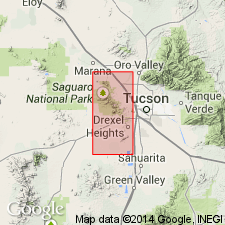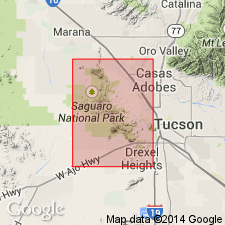
- Usage in publication:
-
- Beehive rhyolite
- Modifications:
-
- Original reference
- Dominant lithology:
-
- Rhyolite
- AAPG geologic province:
-
- Basin-and-Range province
Summary:
Pg. 740-741. Beehive rhyolite. Described as massive porphyritic biotite rhyolite. Makes up two intersecting dikes which form a small but prominent spire called Beehive Peak. Believed to represent a volcanic neck. Spire rises above a mass of biotite rhyolite believed to have come from the volcanic neck. Age is Tertiary.
Exposed in and around Beehive Peak, Tucson Mountains, Pima Co., AZ. Presumably named from Beehive Peak.
Source: US geologic names lexicon (USGS Bull. 1200, p. 273).

- Usage in publication:
-
- Beehive rhyolite†
- Modifications:
-
- Abandoned
Summary:
Abandoned in Tucson Mountains, Pima Co, AZ, Basin-and-Range province. Replaced by informal tuff of Beehive Peak. [Author uses original spelling "Beehive rhyolite" of Brown (1939).] Unit also previously called "biotite rhyolite" by Bikerman, Damon (1966, GSA Bull., v. 77, p. 1225-1234). Tuff of Beehive Peak is light-gray to tan massive welded dacite ash-flow tuff; characterized by abundant small angular fragments of Cretaceous sandstone and intermediate-composition volcanic rocks. Previously interpreted as an intrusive rock by Brown and Bikerman, Damon. Informal name "tuff of Beehive Peak" is proposed because these rocks are of local occurrence (a few square km), have been referred to by various names, and are dacite rather than rhyolite. Age relations of tuff of Beehive Peak are uncertain with nearby postcaldera lavas due to lack of exposed contacts. Thickness of tuff is locally 250 m. K-Ar biotite age of tuff of Beehive Peak is 60.2 +/-1.8 Ma though may be only minimum age, therefore, assigned Late Cretaceous or early Tertiary age.
Source: GNU records (USGS DDS-6; Denver GNULEX).
For more information, please contact Nancy Stamm, Geologic Names Committee Secretary.
Asterisk (*) indicates published by U.S. Geological Survey authors.
"No current usage" (†) implies that a name has been abandoned or has fallen into disuse. Former usage and, if known, replacement name given in parentheses ( ).
Slash (/) indicates name conflicts with nomenclatural guidelines (CSN, 1933; ACSN, 1961, 1970; NACSN, 1983, 2005, 2021). May be explained within brackets ([ ]).

